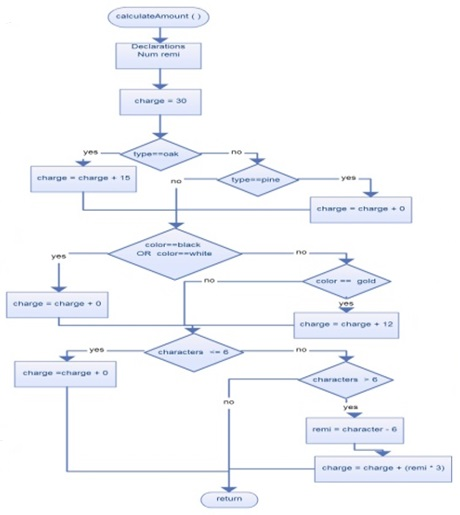
Programming Logic and Design, Introductory 7th Edition by Joyce Farrell
Edition 7ISBN: 1285225562
Programming Logic and Design, Introductory 7th Edition by Joyce Farrell
Edition 7ISBN: 1285225562Mark Daniels is a carpenter who creates personalized house signs. He wants an application to compute the price of any sign a customer orders, based on the following factors: The minimum charge for all signs is $30. If the sign is made of oak, add $15. No charge is added for pine. The first six letters or numbers are included in the minimum charge; there is a $3 charge for each additional character. Black or white characters are included in the minimum charge; there is an additional $12 charge for gold-leaf lettering. Design a flowchart or pseudocode for the following:
a. A program that accepts data for an order number, customer name, wood type, number of characters, and color of characters. Display all the entered data and the final price for the sign.
b. A program that continuously accepts sign order data and displays all the relevant information for oak signs with five white letters.
c. A program that continuously accepts sign order data and displays all the relevant information for pine signs with gold-leaf lettering and more than 10 characters.
Step 1 of 15
a.
Flowchart:
Flowchart for mark Daniels carpenter workshop order booking is as follows:

The variables one, oak, pine, type, black, white, gold, color, character and charge of type number and name of type string are declared in the main program.
The methods acceptOder(), calculateAmount() and Display() are called simultaneously.

The above flowchart defines the method acceptOrder(). When this method is executed, a series of input and output statements are executed to read and initiate values for variables declared in the main method.

Step 2 of 15
Step 3 of 15
Step 4 of 15
Step 5 of 15
Step 6 of 15
Step 7 of 15
Step 8 of 15
Step 9 of 15
Step 10 of 15
Step 11 of 15
Step 12 of 15
Step 13 of 15
Step 14 of 15
Step 15 of 15
Why don’t you like this exercise?
Other


